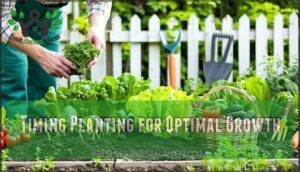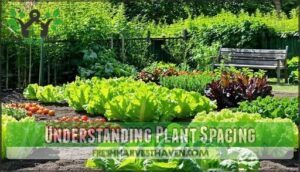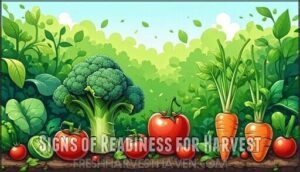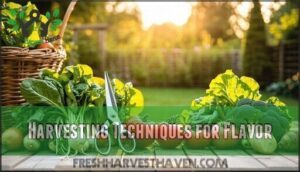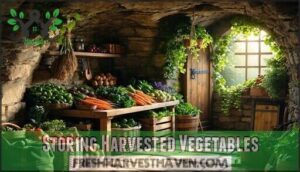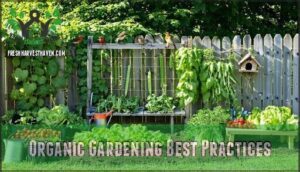This site is supported by our readers. We may earn a commission, at no cost to you, if you purchase through links.
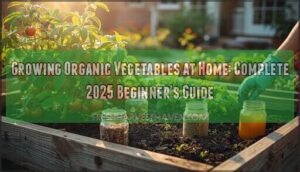
You’ll prepare nutrient-rich soil using compost and organic matter, then select vegetables suited to your space and climate.
Plant seeds at the right depth and spacing, water consistently, and maintain soil health through natural methods.
Skip synthetic pesticides—use companion planting and beneficial insects instead.
Start small with easy crops like lettuce, tomatoes, and herbs. Container gardening works perfectly for apartments or limited space.
The key is understanding your soil’s needs and timing your plantings correctly. Success depends on mastering a few fundamental techniques that transform beginners into confident organic gardeners.
Table Of Contents
- Key Takeaways
- Starting Organic Garden
- Planting Organic Vegetables
- Maintaining Organic Gardens
- Harvesting Organic Vegetables
- Organic Gardening Best Practices
- Frequently Asked Questions (FAQs)
- How to start an organic garden for beginners?
- What are the healthiest vegetables to grow at home?
- Is it hard to grow organic vegetables?
- What is the easiest crop to grow organically?
- What is the best way to grow organic vegetables?
- Is it really cheaper to grow your own vegetables?
- How to start an organic vegetable garden in your backyard?
- How to start an organic vegetable garden?
- Should you grow your own organic vegetables garden at home?
- How do you grow an organic garden?
- Conclusion
Key Takeaways
- Start with soil preparation – You’ll need nutrient-rich soil with a 6.0-7.2 pH, enriched with compost and organic matter for healthy plant growth and proper drainage.
- Choose quality organic seeds and plan timing – Select certified organic, non-GMO varieties suited to your climate zone and plant at the right seasonal timing for maximum success.
- Master natural maintenance methods – You’ll maintain soil health through consistent watering, organic mulching, and natural pest control using companion planting instead of synthetic chemicals.
- Begin small with easy crops – Start with beginner-friendly vegetables like lettuce, tomatoes, and herbs, using container gardening if you have limited space.
Starting Organic Garden
Starting your organic garden begins with three essential foundations that determine your harvest success.
You’ll need to prepare nutrient-rich soil, select certified organic seeds, and establish a reliable compost system for natural fertilization to ensure a successful harvest with certified organic seeds.
Preparing Garden Soil
Start with soil testing to determine pH levels and nutrient content—most vegetables thrive when pH ranges from 6.0 to 7.2.
Mix compost or well-aged manure into your garden soil, aiming for 3-5% organic matter content.
This soil preparation creates the foundation for healthy plant growth through improved drainage and natural fertilizers.
Understanding soil health basics is essential for maintaining a thriving garden ecosystem.
Choosing Organic Seeds
Now that your soil’s ready, you’ll want to choose organic seeds that’ll give you the best harvest.
Focus on certified organic varieties and non-GMO options for healthier vegetables.
Heirloom seeds offer unique flavors and can be saved for next season’s planting.
Quality seed selection makes all the difference in your organic gardening success, so invest in reputable suppliers for superior results.
Understanding soil health benefits is essential for selecting the right seeds and creating a thriving garden ecosystem.
Creating Compost for Fertilizer
Once you’ve selected quality organic seeds, composting transforms kitchen scraps into nutrient-rich organic fertilizers for your garden.
This waste reduction practice creates superior organic matter through natural nutrient cycling, delivering essential soil enrichment that store-bought fertilizers can’t match.
Effective composting requires these key compost materials:
Transform kitchen scraps into black gold that feeds your garden naturally—no chemicals required.
- Green materials: Fruit and vegetable scraps provide nitrogen for microbial activity
- Brown materials: Dried leaves and cardboard supply carbon and balance moisture levels
- Proper ratios: Use 1:3 green-to-brown ratio by volume for ideal decomposition
- Adequate size: Build piles at least 3x3x3 feet for effective heat retention
- Regular maintenance: Turn every 1-2 weeks and maintain 40-60% moisture content
This organic gardening method produces finished compost in 2-4 months, creating dark, crumbly fertilizer that increases soil water retention by 25-40% while supporting beneficial microbes that naturally protect your vegetables.
Planting Organic Vegetables
You’ll transform your carefully prepared soil into a thriving vegetable garden by mastering three essential planting techniques.
Proper timing, spacing, and seed depth determine whether your organic vegetables flourish or struggle from the start, which is crucial for a successful harvest with proper care.
Timing Planting for Optimal Growth
Mastering seasonal sowing transforms your garden from amateur hour to harvest hero.
Cool-season crops thrive when planted 2-4 weeks before frost, while warm-season vegetables need soil temperatures above 60°F.
Check your climate zone’s plant schedules and use succession planting every 2-3 weeks.
This strategic timing maximizes growth stages and extends your harvest season substantially.
Understanding Plant Spacing
Proper plant arrangement transforms your vegetable garden into a productivity powerhouse.
You’ll maximize crop density while ensuring adequate soil depth for root development.
Space lettuce 4-6 inches apart, tomatoes 18-24 inches, and carrots 2-3 inches for ideal garden layout.
These spacing techniques prevent overcrowding, improve air circulation, and boost plant growth through strategic garden design and organic gardening techniques.
Effective use of garden spacing tools is essential for achieving the perfect plant arrangement.
Planting Seeds at Right Depth
After determining proper spacing between your plants, you’ll need to master seed depth for maximum germination. Each seed variety requires specific planting depth to access adequate moisture while avoiding suffocation in heavy soil.
Use these planting techniques for consistent depth control:
- Small seeds (lettuce, carrots): Plant at depth equal to 2-3 times seed diameter
- Medium seeds (beans, corn): Use your finger to create holes 1-2 inches deep
- Large seeds (squash, cucumbers): Plant 1-2 inches deep with loose soil covering
- Planting tools: Dibbers and seed spacing rulers guarantee consistent seed placement
- Soil preparation: Well-draining, organic-rich soil improves germination rates substantially
Proper seed depth creates the foundation for successful vegetable gardening and healthy organic growth. Understanding seed starting tips is vital for achieving maximum germination and healthy seedling development.
Maintaining Organic Gardens
Once your organic vegetables are planted, you’ll need to master consistent care practices to guarantee healthy growth throughout the season.
Proper watering, soil management, and pest control determine whether your garden thrives or struggles during critical growing months.
Watering Techniques for Growth
After planting your organic vegetables correctly, you’ll need smart watering techniques to maximize their growth potential.
Water deeply but less frequently to encourage strong root development. Monitor soil moisture levels regularly and adjust your schedule based on weather conditions.
| Watering Method | Best For | Water Efficiency | Setup Difficulty | Cost Range |
|---|---|---|---|---|
| Drip Irrigation | Large gardens | Excellent | Moderate | $50-200 |
| Soaker Hoses | Row crops | Good | Easy | $20-60 |
| Sprinkler Systems | Broad coverage | Fair | Complex | $100-500 |
| Hand Watering | Small plots | Variable | None | $10-30 |
| Rainwater Harvesting | All gardens | Outstanding | Moderate | $75-300 |
These watering techniques help conserve water while promoting healthy vegetable growth in your organic garden.
Maintaining Soil Moisture
Consistent soil moisture is your garden’s insurance policy against drought stress and nutrient deficiencies.
Mulch benefits include reducing water evaporation by up to 70%, creating natural water retention.
Install drip irrigation systems for precise moisture levels, delivering water directly to root zones.
Monitor soil health regularly by checking moisture two inches deep using your finger test to ensure optimal soil moisture.
Managing Pests and Diseases
Beyond maintaining soil moisture, you’ll need to tackle pest control and disease prevention to protect your harvest.
Organic sprays, crop rotation, and biological management form your defense strategy against garden pests. Natural pest control methods reduce chemical dependency while organic pest management preserves beneficial insects that support your ecosystem.
Understanding the roles of beneficial insects roles is essential for maintaining ecosystem balance.
- Watch aphids multiply overnight – they can infest 75% of untreated gardens during peak season
- Discover cabbage worms silently destroying your brassicas, reducing yields by 25% without intervention
- Feel frustration when slugs devour 10-15% of your precious leaf crops annually
- Experience spider mites stunting growth during dry, dusty conditions when plants need moisture most
Harvesting Organic Vegetables
The moment you’ve been waiting for has finally arrived—it’s time to harvest your homegrown organic vegetables and enjoy the fruits of your labor.
Knowing when and how to harvest properly guarantees maximum flavor, nutrition, and storage life for your fresh produce, ensuring you get to enjoy the full benefit of your labor.
Signs of Readiness for Harvest
Perfect timing matters when growing organic vegetables at home.
**Harvest timing isn’t just important—it’s everything for flavor and nutrition.
Visual cues like full tomato coloration and firm broccoli heads signal readiness. Texture changes—snap beans that break crisply, tender zucchini skin—indicate ideal harvest windows.
Size matters: carrots showing shoulders, cucumbers at six inches. Aroma intensity peaks in melons and herbs before flowering.
These harvest techniques guarantee maximum flavor and nutrition from your garden. Understanding the vegetable harvest planning guide is vital for a successful harvest, with perfect timing and maximum flavor.
Harvesting Techniques for Flavor
Sharp kitchen shears make clean cuts that preserve cell walls, keeping flavors locked inside.
Harvest during cool morning hours when vegetables hold peak moisture content.
Cut leafy greens above growing points to encourage regrowth.
For root vegetables, gently twist and pull to avoid bruising tender flesh that affects taste quality.
Storing Harvested Vegetables
Proper vegetable storage extends your homegrown produce’s shelf life substantially.
Store root vegetables like carrots and potatoes in cool, dark root cellars or basements.
Fresh vegetables need different harvest preservation methods—leafy greens require refrigeration while tomatoes stay fresh at room temperature.
Quick harvest cooling after picking maintains quality.
Your garden harvest deserves thoughtful crop protection through proper food preservation techniques, using methods like quick harvest cooling.
Organic Gardening Best Practices
Success comes from applying the right techniques consistently throughout your growing season. These proven methods will maximize your harvest while maintaining healthy soil and plants for years to come.
Using Organic Mulch for Weed Control
After your excellent harvest, organic mulch becomes your home vegetable garden’s first line of defense against weeds.
Organic barriers like straw effectively block weed emergence by preventing light from reaching seeds, while providing additional mulch benefits for your organic vegetable gardening efforts:
- Straw mulch – Apply 3-4 inches thick for maximum weed suppression around established plants
- Grass clippings – Use chemical-free clippings to create moisture retention while controlling weeds
- Shredded leaves – Layer 2-3 inches deep to regulate soil temperature and suppress emerging weeds
- Wood chips – Spread between rows for long-lasting organic gardening methods and weed control
- Compost – Top-dress beds with finished compost to feed plants while blocking unwanted growth
Using organic mulch materials can substantially enhance soil health and weed management in your garden.
Selecting Heirloom and Hybrid Seeds
Your seed selection shapes your garden’s future success.
Heirloom seeds offer superior flavor profiles and genetic stability for seed saving, while hybrid varieties provide disease resistance and consistent yields.
Consider your priorities: heirlooms excel in taste and crop diversity, hybrids deliver predictable performance.
Balance both types for ideal organic vegetable gardening results.
Sourcing High-Quality Organic Seeds
Quality seed sourcing transforms your organic gardening success.
You’ll find reputable organic suppliers through certified seed companies, local nurseries, and gardening cooperatives.
Prioritize non-GMO options and heirloom seeds for superior flavor and genetic diversity.
Check seed quality indicators like germination rates, organic certification labels, and harvest dates for ideal vegetable gardening results.
Understanding organic seed options is essential for making informed decisions about your organic gardening and selecting the best seed quality.
Frequently Asked Questions (FAQs)
How to start an organic garden for beginners?
Choose a sunny location with well-draining soil. Start small with easy crops like lettuce, tomatoes, and herbs. Test your soil, add compost, and avoid synthetic fertilizers or pesticides completely.
What are the healthiest vegetables to grow at home?
Leafy greens like spinach, kale, and lettuce provide maximum nutrition with minimal space. Root vegetables including carrots, radishes, and beets offer excellent storage value and consistent harvests for beginners.
Is it hard to grow organic vegetables?
Growing organic vegetables isn’t particularly challenging—it’s more like embracing nature’s rhythm rather than fighting it.
You’ll need patience, consistent watering, and quality soil, but the process becomes surprisingly straightforward once you establish good habits.
What is the easiest crop to grow organically?
Radishes are your gateway to organic success – they’re virtually foolproof, sprouting in just days and ready to harvest within a month, even tolerating beginner mistakes gracefully.
What is the best way to grow organic vegetables?
Unlike chemical-laden conventional methods, organic vegetable growing starts with healthy soil. Build nutrient-rich beds using compost, practice crop rotation, choose disease-resistant varieties, and use natural pest management.
Is it really cheaper to grow your own vegetables?
Yes, you’ll typically save money growing your own vegetables, especially with high-value crops like herbs, lettuce, and tomatoes. Initial setup costs pay off within one season through reduced grocery bills.
How to start an organic vegetable garden in your backyard?
Like Rome wasn’t built in a day, your garden won’t sprout overnight.
Choose a sunny spot, test your soil’s pH, add compost, select easy vegetables like lettuce and tomatoes, then plant according to package directions, remembering that complete concepts like these are crucial for a successful garden.
How to start an organic vegetable garden?
Choose a sunny location with well-draining soil.
Test soil pH (0-0 is ideal). Add compost to enrich nutrients.
Start with easy crops like lettuce, tomatoes, and herbs. Plant according to your climate zone’s schedule.
Should you grow your own organic vegetables garden at home?
Despite limited space or gardening experience, you can successfully grow organic vegetables at home.
Container gardening maximizes small areas while delivering fresh, pesticide-free produce that’s more nutritious and flavorful than store-bought alternatives.
How do you grow an organic garden?
Start with quality soil enriched with compost and organic matter.
Choose certified organic seeds suited to your climate.
Water consistently, use natural pest control methods like companion planting, and avoid synthetic chemicals throughout, ensuring a safe and healthy environment with natural pest control.
Conclusion
Rome wasn’t built in a day, and neither is a thriving organic garden.
However, you’ve now equipped yourself with all the essential knowledge for growing organic vegetables at home successfully.
Start with quality soil preparation, choose appropriate seeds for your climate, and maintain consistent watering practices.
Remember that organic gardening rewards patience and observation.
Your first harvest will taste better than anything from the store, proving that homegrown organic vegetables are worth every effort invested.
- https://www.youtube.com/watch?v=Z5QjZlztLFM
- https://www.charlesdowding.co.uk/resources/compost
- https://www.masterclass.com/articles/types-of-seeds-heirloom-hybrid-and-open-pollinated-seeds
- https://blog.seedsavers.org/blog/open-pollinated-heirloom-and-hybrid-seeds
- https://hudsonvalleyseed.com/blogs/blog/heirloom-open-pollinated-or-hybrid?srsltid=AfmBOor6Ghr7dmvgyWPhg-sTXaKr8n7KzR7pFIwYI7essnxGnH1pdKGf

